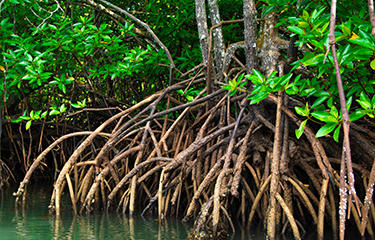The Sustainable Fisheries Partnership (SFP) partnered with Longline Environment to develop a new map-based tool to identify shrimp farming locations close to mangroves to identify “hot spots” for industry attention so shrimp farming can be a driver for mangrove restoration and protection.
“Mangroves should not be lost to aquaculture or indeed any other purpose as they are a habitat under threat and provide a wide range of established ecosystem services, including carbon capture, livelihoods for communities, and coastal protection. Conserving the existing and established mangrove systems is therefore the number-one priority,” SFP Aquaculture Information Manager Paul Bulcock said.
Honolulu, Hawaii, U.S.A-based nonprofit SFP operates globally to engage fishery stakeholders and seafood businesses to promote sustainable seafood production. An SFP industry brief, "How Coastal Shrimp Farming Can Support Mangrove Regeneration," lists mangrove the benefits of robust mangrove ecosystems, including nurseries for marine species, homes for migratory species, and protection for coastal communities from pollutants to coastal flooding. London, U.K.-based Longline Environment, meanwhile employs scientists and engineers to provide solutions through technology.
Mangroves account for more than USD 80 billion (EUR 70 billion) per year in avoided losses from coastal flooding and protect an estimated 18 million people, according to the Global Center on Adaptation and World Resources Institute. The ecosystem also sequesters carbon at up to four times the rate of terrestrial forests, according to Global Mangrove Watch.
“Mangrove conservation and restoration demonstrates that farms are being managed more effectively and therefore addresses reputational issues. Specifically, the perception that shrimp farming equals habitat loss. It also helps farms meet the environmental, social, and governance commitments of seafood buyers,” Bulcock said. “Their services protect against storm surges and reduce risks to the long-term existence of coastal farms. Hence it potentially attracts the attention of the insurance and investment sector. They protect neighboring ecosystems by reducing sedimentation and capturing nutrients and pollutants from the water column.”
Shrimp farming has caused the deforestation of 30 percent of mangroves and multiple coastal land use changes. Though direct conversion of mangroves to shrimp ponds is now reduced, it still continues in parts of Indonesia and Vietnam, providing an opportunity for the shrimp-farming industry to become one of the driving forces for mangrove restoration if incentivized by retailers and consumers, according to SFP.
“The reasons for this [reduced conversion] need to be investigated further but are potentially related to enforcement capacity – the enforcement of existing legislation, spatial plans, etc. (all of which overwhelmingly include criteria on mangrove protection and prohibit siting ponds in these environments) needs to be strengthened," Bulcock said. "Extensive farming - these systems rely on the supply of inputs via natural tidal water exchange and therefore are sited in the intertidal zone where mangroves are located. Sometimes they are integrated with mangroves, sometimes not.”
Mangrove and intertidal areas are not suitable habitats for intensive forms of shrimp farming, Bulcock said. The reasons for this include the need for regular tidal water exchange, high organic matter in mangrove soil, and low dissolved oxygen concentration resulting in water-quality problems, as well as issues with acidic soils and difficulty in pond construction.
Abandoned and inactive aquaculture ponds provide the perfect setting for mangrove recovery, and SFP said its new map of such "hotspots" could help facilitate this regeneration. To restore the full range of benefits of the mangrove ecoystem, SFP said a key focus should be on mangrove regeneration at a landscape level to reduce habitat fragmentation by physically linking patches of mangroves. Certification schemes alone fall short of full restoration as the focus is on the farm level, but SFP said it aims to take a combined landscape approach by working with farmers, suppliers, and stakeholders.
The map tool SFP introduced in the report allows stakeholder engagement in mangrove restoration efforts by finding shrimp farming locations that are within or adjacent to mangrove habitats in India, Indonesia, Thailand, and Vietnam. Together, the mapping tool and shrimp-sourcing information can identify target areas for landscape-level regeneration.
“We have developed a tool in association with Longline Environment that identifies coastal shrimp ponds and whether they are located in or adjacent to mangroves or not. It’s a high-level overview identifying where the mangrove to shrimp farming hotspots are at the local level. Therefore, it quickly identifies where to focus efforts on mangrove restoration and protection. The tool also provides information on pond types, whether they are abandoned or active, as well as their proximity to established mangrove systems,” Bulcock said. “It can quickly help identify the appropriate approach by those interested in restoring mangroves from shrimp ponds as part of project scoping. The tool is not intended to be public at this time, but it is fully operational and available for use by SFP partners and collaborators.”
SFP recommends shrimp buyers and suppliers help with restoration efforts by identifying their sourcing at the provincial level, where SFP can help assess if mangrove loss is occurring or is a risk. SFP asked importers to join the Asian Farmed Shrimp Supply Chain Roundtable, and called on them to communicate to processors, packers, and exporters to inquire about mangrove restoration.
Companies benefit from progress on restoration efforts through the ...
Photo courtesy of Nattapong2012/Shutterstock








